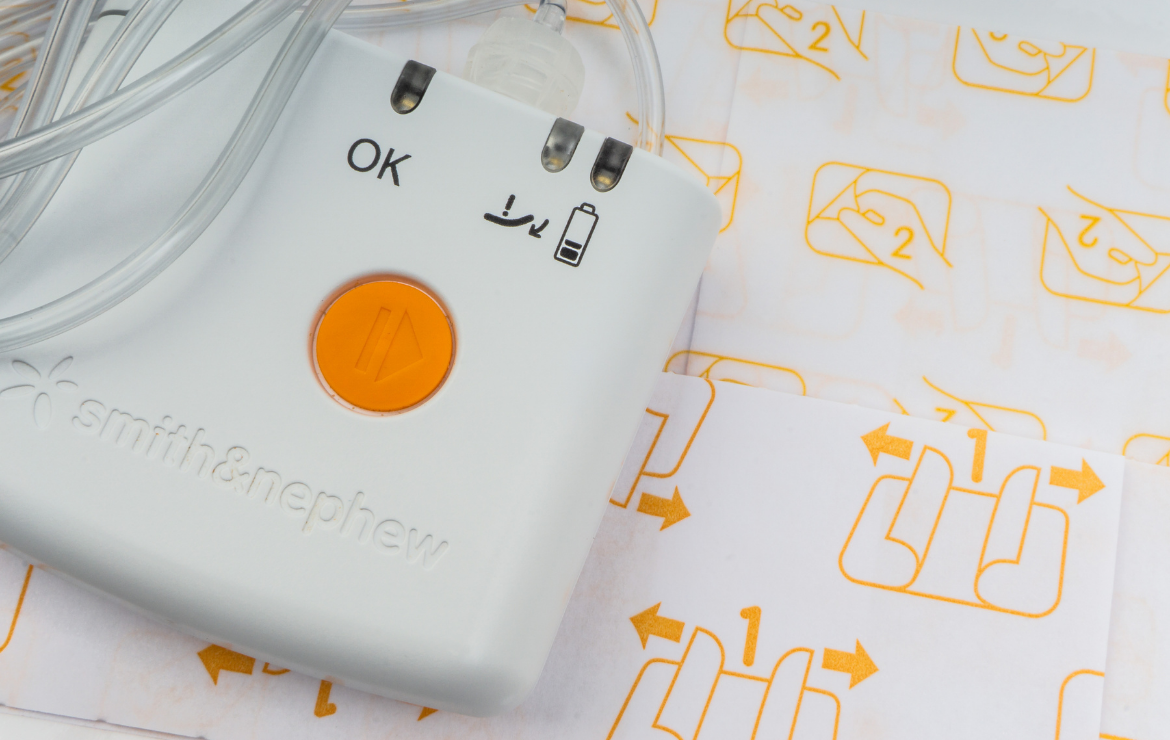Advanced techniques for improving the rate of wound healing in acute and chronic non-healing wounds have continued to show promise over several decades. One such method is Negative Pressure Wound Therapy (NPWT), which aims to facilitate wound healing by modifying the pressure over a wound surface. This article will discuss NPWT, its efficacy, benefits to patients, as well as some known limitations.
What is Negative Pressure Wound Therapy?
Negative pressure wound therapy (NPWT), also known as vacuum-assisted wound closure (VAC) is a technique for improving the rate of wound healing using wound dressings and a vacuum device to apply intermittent pressure to the wound bed. The amount of pressure applied is usually lower than that of the atmosphere (subatmospheric). NPWT stabilizes the wound environment by draining excess fluid, minimizing edema, and pressurizing the wound bed to induce angiogenesis.
The first documented attempt exploring the use of VAC to manage slow-healing wounds was in 1997 by L.C. Argenta and M. J. Morykwas, who used the technique to treat 300 patients, 296 of chronic and acute cases showed favorable results. Today, the procedure remains just as effective, as negative pressure device technology is more efficient.
How Does NPWT Work?
Air is a mixture of gases that exist all around us and exerts some pressure on our body surfaces. Research has shown that lowering the atmospheric pressure over a wound can promote healing. A VAC system consists of suitable wound dressings and a battery-powered device for generating required suction. Let's take a closer look at these elements:
Wound Dressings for NPWT
Several kinds of wound dressings are appropriate for NPWT, including foam dressings, woven gauze, and transparent films. The choice of dressing will depend on the nature of the wound, size, skin integrity, patient's age, and clinical objectives. For example, foam and gauze are suitable for open cavity wounds.
Negative Pressure Devices
VAC devices are battery-powered and consist of a pump and drainage tubing. Vacuum systems may run continuously or intermittently (On/Off) throughout the day. Most devices deliver a pressure of between −200 and −40 mmHg, which aids wound healing. They also contain a disposable canister for collecting exudate from the wound.
Procedure
A wound care professional applies a primary wound dressing to the open wound (e.g., foam or gauze). Usually, the person cuts these to fit the size and shape of the area. Then, the professional places a drain tube on the dressing and applies an adhesive transparent film over as a secondary barrier and vacuum seal. The other end of the drain tube should connect to the battery-powered negative pressure device. When the unit is on, it should intermittently create suction, causing the foam dressing to collapse inwards and pulling the edges of the wound together. As this occurs, fluid from the wound bed also drains into the canister attached to the device. Depending on the nature of a patient's wounds or quantity of exudate, dressings will need to be changed once a week or up to several times daily.
What Types of Wounds are Appropriate for NPWT?
NPWT has proven to promote healing in both acute and chronic wounds with medium to heavy exudate. Examples include traumatic and dehisced injuries, diabetic foot ulcers, pressure ulcers, and venous insufficiency ulcers. Negative pressure can also improve wound healing in skin grafts and flaps.
Benefits of NPWT
The following are some benefits of negative pressure therapy for wound healing:
- Gradually drains excess fluid (exudate) from the wound bed
- Stimulates antibacterial action to prevent wound infections
- Reduces swelling (edema)
- Improves blood circulation in the wound bed
- Facilitates the growth of new tissue (granulation)
- Promotes a moist wound healing environment
- Helps to pull the edges of wounds together, aiding faster closure
- Minimizes inflammation (redness and swelling)
Contraindications
Negative pressure wound therapy is unsuitable for use in the patients having any of the following conditions:
- Fistula (a medical condition where there is an abnormal connection between the skin and the stomach or intestinal tract)
- Malignant wounds (e.g., those due to skin cancer)
- Untreated osteomyelitis (bone infections)
- Wounds containing necrotic tissue with un-debrided eschar
- Fragile or compromised skin (e.g., in older patients or due to prolonged use of topical steroids
NPWT also has some risks which, although rare, may affect some patients. These include wound infection, bleeding, and enteric fistula. However, wound care experts can mitigate these risks by carrying out a careful evaluation of each patient to determine if they could be good candidates for negative pressure wound therapy.



.webp)

.avif)